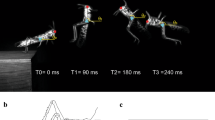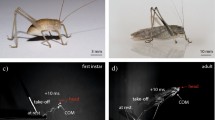Abstract
We investigated the escape jumps that locusts produce in response to approaching objects. Hindleg muscular activity during an escape jump is similar to that during a defensive kick. Locusts can direct their escape jumps up to 50° either side of the direction of their long axis at the time of hindleg flexion, allowing them to consistently jump away from the side towards which an object is approaching. Variation in jump trajectory is achieved by rolling and yawing movements of the body that are controlled by the fore- and mesothoracic legs. During hindleg flexion, a locust flexes the foreleg ipsilateral to its eventual jump trajectory and then extends the contralateral foreleg. These foreleg movements continue throughout co-contraction of the hindleg tibial muscles, pivoting the locust’s long axis towards its eventual jump trajectory. However, there are no bilateral differences in the motor programs of the left and right hindlegs that correlate with jump trajectory. Foreleg movements enable a locust to control its jump trajectory independent of the hindleg motor program, allowing a decision on jump trajectory to be made after the hindlegs have been cocked in preparation for a jump.







Similar content being viewed by others
Abbreviations
- FPS:
-
Frames per second
- emg:
-
Electromyogram
- FETi:
-
Fast extensor tibiae motor neuron
- SETi:
-
Slow extensor tibiae motor neuron
References
Bennet-Clark HC (1975) The energetics of the jump in the locust Schistocerca gregaria. J Exp Biol 63: 53–83
Bicker G, Pearson KG (1983) Initiation of flight by an identified wind sensitive neurone (TCG) in the locust. J Exp Biol 104: 289–293
Brown RHJ (1967) Mechanism of locust jumping. Nature 214: 939
Burrows M (1995) Motor patterns during kicking movements in the locust. J Comp Physiol A 176: 289–305
Burrows M, Morris G (2001) The kinematics and neural control of high-speed kicking movements in the locust. J Exp Biol 204: 3471–3481
Burrows M, Wolf H (2002) Jumping and kicking in the false stick insect Prosarthria teretrirostris: kinematics and motor control. J Exp Biol 205: 1519–1530
Collett TS, Paterson CJ (1991) Relative motion parallax and target localisation in the locust, Schistocerca gregaria. J Comp Physiol A 169: 615–621
Eriksson ES (1980) Movement parallax and distance perception in the grasshopper (Phaulacridium vittatum (Sjöstedt)). J Exp Biol 86: 337–340
Godden DH (1969) The neural basis of locust jumping. American Zoologist 9: 1139–1140
Gynther IC, Pearson KG (1989) An evaluation of the role of identified interneurons in triggering kicks and jumps in the locust. J Neurophysiol 61: 45–57
Hassenstein B, Hustert R (1999) Hiding responses of locusts to approaching objects. J Exp Biol 202: 1701–1710
Heitler WJ (1974) The locust jump: specialisations of the metathoracic femoral-tibial joint. J Comp Physiol 89: 93–104
Heitler WJ, Burrows M (1977) The locust jump I: the motor programme. J Exp Biol 66: 203–219
Hoyle G, Burrows M (1973) Neuromuscular mechanisms underlying behaviour in the locust Schistocerca gregaria. J Neurobiol 4: 3–41
Pearson KG, Robertson RM (1981) Interneurons coactivating hindleg flexor and extensor motoneurons in the locust. J Comp Physiol A 144: 391–400
Pflüger H-J, Burrows M (1978) Locusts use the same basic motor pattern in swimming as in jumping and kicking. J Exp Biol 75: 81–93
Sobel EC (1990) The locust’s use of motion paralax to measure distance. J Comp Physiol A 167: 579–588
Acknowledgements
Supported by the BBSRC (Grant 13/S17899), and a JSPS visiting fellowship to YY. The experiments described in this manuscript comply with the ‘Principles of animal care’, publication No. 86-23 revised 1985, of the National Institute of Health and also with the current laws of the UK.
Author information
Authors and Affiliations
Corresponding author
Rights and permissions
About this article
Cite this article
Santer, R.D., Yamawaki, Y., Rind, F.C. et al. Motor activity and trajectory control during escape jumping in the locust Locusta migratoria . J Comp Physiol A 191, 965–975 (2005). https://doi.org/10.1007/s00359-005-0023-3
Received:
Revised:
Accepted:
Published:
Issue Date:
DOI: https://doi.org/10.1007/s00359-005-0023-3




